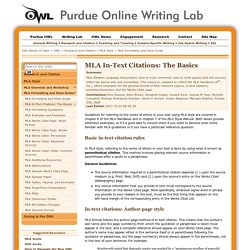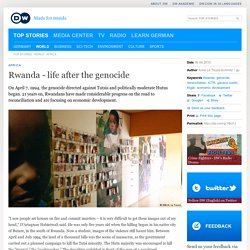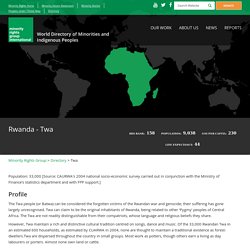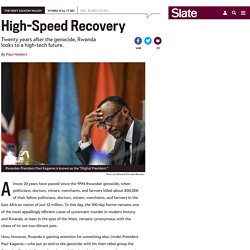

MLA Formatting and Style Guide. Summary: MLA (Modern Language Association) style is most commonly used to write papers and cite sources within the liberal arts and humanities.

This resource, updated to reflect the MLA Handbook (8th ed.), offers examples for the general format of MLA research papers, in-text citations, endnotes/footnotes, and the Works Cited page. Contributors:Tony Russell, Allen Brizee, Elizabeth Angeli, Russell Keck, Joshua M. Paiz, Michelle Campbell, Rodrigo Rodríguez-Fuentes, Daniel P. Kenzie, Susan Wegener, Maryam Ghafoor, Purdue OWL StaffLast Edited: 2017-10-23 08:53:38 Guidelines for referring to the works of others in your text using MLA style are covered in chapter 6 of the MLA Handbook and in chapter 7 of the MLA Style Manual. Basic in-text citation rules In MLA style, referring to the works of others in your text is done by using what is known as parenthetical citation.
General Guidelines The source information required in a parenthetical citation depends (1.) upon the source medium (e.g. Timeline: 100 days of genocide. Some 800,000 Rwandans, mainly Tutsis, were murdered in a 100-day period following the killing of the Hutu president of Rwanda, Juvenal Habyarimana.

The presidential guard quickly murdered the political opposition and enacted a pre-planned campaign of slaughter that spread across the country. Soldiers, government officials and business leaders organised the killings and were joined by a Hutu militia, the Interahamwe. The international community did little to stop the killings and the slaughter was brought to end by the military defeat of the government by the Rwandan Patriotic Front, a Tutsi-led rebel group. 6 April 1994: President Habyarimana and Burundian President Cyprien Ntaryamira are killed when the Rwandan leader's plane is shot down as it is about to land at Kigali Airport.
Hutu extremists opposed to the Arusha Peace Accords are believed to be behind the attack. 100 Days Of Slaughter. Rwanda - life after the genocide. "I saw people set houses on fire and commit murders – it is very difficult to get these images out of my head," D'Artagnan Habintwali said.

20 years after the genocide, Rwanda is a beacon of hope. In July 1994 Rwanda was a shell of a nation.
Some 800,000 people had been killed, over 300 lives lost every hour for the 100 days of the genocide, and millions more displaced from their homes. Its institutions, systems of government, and trust among its people were destroyed. There was no precedent for the situation it found itself in: desperately poor, without skilled labour and resources, and the people demoralised and divided. Very few expected the country to achieve more than high levels of sympathy. But under the leadership of President Paul Kagame, Rwanda decided to start afresh; to begin a unique experiment in post-conflict nation building, which would steer it away from intractable cycles of killing. For the last five years, my foundation – the Africa Governance Initiative – which provides countries with the capacity to deliver practical change, has been operating in Rwanda.
Over the last decade economic growth has exceeded 8% per annum. MLA Formatting and Style Guide. Titled. By 1994, Rwanda’s population stood at more than 7 million people comprising three ethnic groups: the Hutu (who made up roughly 85% of the population), the Tutsi (14%) and the Twa (1%).

Prior to the colonial era, Tutsis generally occupied the higher strata in the social system and the Hutus the lower. However, social mobility was possible, a Hutu who acquired a large number of cattle or other wealth could be assimilated into the Tutsi group and impoverished Tutsi would be regarded as Hutu. A clan system also functioned, with the Tutsi clan known as the Nyinginya being the most powerful. Throughout the 1800s, the Nyingiya expanded their influence by conquest and by offering protection in return for tribute.
Ethnic Conflict Begins The former colonial power, Germany, lost possession of Rwanda during the First World War and the territory was then placed under Belgian administration. A new cycle of ethnic conflict and violence continued after independence. Twa - Minority Rights Group. Population: 33,000 [Source: CAURWA's 2004 national socio-economic survey carried out in conjunction with the Ministry of Finance's statistics department and with FPP support.]

Profile The Twa people (or Batwa) can be considered the forgotten victims of the Rwandan war and genocide; their suffering has gone largely unrecognised. Twa can claim to be the original inhabitants of Rwanda, being related to other ‘Pygmy' peoples of Central Africa. The Twa are not readily distinguishable from their compatriots, whose language and religious beliefs they share. However, Twa maintain a rich and distinctive cultural tradition centred on songs, dance and music. Historical context Before independence a small number of Twa obtained a privileged position at the Tutsi royal court as entertainers (and in a few cases as executioners). Rwanda’s high-tech future: 20 years after genocide, the nation aspires to be a tech hub.
Photo by Edward Echwalu/Reuters.

Rwanda Genocide documentary. Rwanda genocide: 100 days of slaughter. Image copyright AFP In just 100 days in 1994, some 800,000 people were slaughtered in Rwanda by ethnic Hutu extremists.
